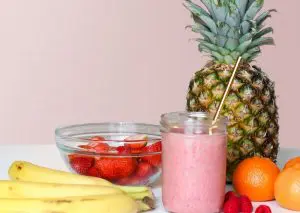Earlier this month, Export Connect hosted a buyer and exporter panel featuring the Operations Director from Chef’s Garden Hong Kong as part of the Agriculture Victoria Export Market Development Programme. During the session, attendees had the opportunity to gain valuable first-hand insights into what’s happening in the Hong Kong market, which we’ll take a look at now!
About the Buyer: Chef’s Garden
Chef’s Garden is a leading Hong Kong’s food supplier and wholesale distributor of premium foods, importing fresh, frozen, dried fruits and vegetables, dairy products, preserves, confectionery, and fresh and delicatessen meats. They work directly with international food & beverage suppliers to import high-quality, sustainable, and safe products to Hong Kong. Chef’s Garden supplies 2,500+ customers, including some of the city’s best-known restaurants, bars, hotels, resorts, and retailers for almost 25 years. The business also has a retail arm, Feather & Bone, which manages almost a dozen retail stores.
Q&A Session Insights
Question 1: Do you want to share a little bit about how Feather & Bone works?
Feather & Bone is our B2C setup (retail & food service) while Chef’s Garden is B2B (distribution). Feather & Bone is a mixed concept between restaurants and grocery shops in Hong Kong, which is a very new concept but has been quite successful for us. Our business model is for Chef’s Garden to bring in a new product alongside the Feather & Bone team, and we sit down and make a collective decision about whether we take or leave the product. It’s been 9 years now and most supermarket buyers visit our Feather & Bone stores regularly to see what new products are on the shelf.
This model requires a mutual understanding between Chef’s Garden and our overseas suppliers. We’re quite selective about picking new products because Feather & Bone only has limited shelf space, so we have to pick the right product to match our positioning. We undertake a lot of evaluation on the market to assess an item’s commercial viability, and once approved, will then move forward with the supplier. But at the end of the day, we only really know how successful a product is when it’s on the shelf. Something that we work with our overseas partners on is their budget for marketing materials to support their launch.
We travel around the world to source products, but we have a long history with Australia and we understand Australian market trends. We want to maintain a strong supply of Australian products, so we travel down regularly to ensure we’re ahead of the trends and can stay connected with our suppliers.
Question 2: From a Hong Kong market perspective, can you share how you see the food and beverage sector is performing at the moment, including retail, foodservice and maybe even e-commerce?
Well, I think the Hong Kong economy is still in the process of getting back to normal. The economy reopened at the end of 2022 and in the food industry, in the retail market, it’s particularly clear that they’re still in the process of getting back to normal. We see that retailers experienced very strong performance during COVID, but in the last 18 months after border reopenings, while the retail market isn’t necessarily struggling, we’re only slowly returning to normal and pre-pandemic operating levels. And of course, the population demographic has changed as some expats have moved away from Hong Kong, who have been somewhat replaced by more mainland Chinese professionals moving into Hong Kong. This is bringing in new changes to food consumption and spending habits. The foodservice sector is calm, but we’re also seeing a lot of new operators setting up their business, particularly from mainland China.
Question 3: It’s an interesting point you raise about Western expats, who have moved home or to Singapore. You’ve got the mainland professionals moving in, also with high disposable incomes like the Western expats who have left. How has that played out on the shelf? Are you seeing that mainland Chinese consumers are consuming different products from the expats that have left? What is the difference with the shift of demographics?
Well, at Feather & Bone, we’re quite focused on Western expats. They haven’t vanished, there are still a lot of Westerners living in Hong Kong and visiting our stores regularly. But yes, we’re seeing the percentage of shoppers shifting with more mainland Chinese consumers coming into our stores and restaurants for lunch or dinner. They do have different kinds of preferences. Say, for example, when it comes to cheese. Chinese consumers aren’t massive cheese lovers, but at Feather & Bone, we sell a lot of fresh meat and this is very popular with our Chinese customers.
Question 4: So the retail scene is slowly returning to pre-COVID levels. In Hong Kong, how is ParknShop performing versus other supermarkets like Wellcome, City Super and Yata etc? Which banners are doing better?
ParknShop and Wellcome are the two biggest in Hong Kong according to volume and business size, and they cover all categories. City Super is quite niche in terms of market positioning. We’re seeing premium banners like City Super attempting to diversify their product portfolio from 95% highly premium products to a lower percentage to get more mass market appeal and to be more shopper-friendly. This is happening to most supermarkets as consumers are looking for value-for-money products as a key priority.
Question 5: In City Super, there are lots of European products. In trying to bring in new products to response to cost of living pressures and demographic changes, are they mostly sourcing local products like from Japan and Korea, or cheaper products from Europe?
It’s obviously more convenient to source local products from surrounding countries like Japan and Korea. The strong US dollar makes local products cheaper, so it’s a dilemma when local products from countries like Japan are getting cheaper. Japanese products are always in demand amongst Hong Kong people, but for Chef’s Garden, we rarely deal with Japanese products. When we look at Australian products, the uniqueness of the product is a key factor for many shoppers.
Question 6: What do you see as the most effective promotion techniques in the Hong Kong market?
We do expect suppliers to spend a few resources on social media to build up some brand awareness among the population. It’s quite important for the Hong Kong people to have an understanding of the brand before they come to the market because, in Hong Kong, it’s so convenient to bring in food from all around the world, whether from Asia, Europe or the States, so consumers in Hong Kong have plenty of choice. So it’s good to have some social media set up already, and then retailers and distributors can easily build off that with promotions. TikTok is not very popular yet, but Instagram and Facebook are very important platforms.
Question 7: What do you see as the biggest barriers for Australian food and beverage companies looking to export to Hong Kong?
I think the demographic changes post-COVID are a challenge. Some suppliers may still be focused on adapting to pre-COVID trends and don’t understand the current condition of the market in Hong Kong, so their strategies may be misaligned with demographic changes. If they’re interested in Hong Kong, I suggest they have a quick talk with potential distributors to understand the market and see if their product is suitable. For instance, the packaging. For Hong Kong, key demographics are small families of 2-4 people, so it’s not ideal to have larger product packages. Retailers like Feather & Bone are very picky when it comes to putting new products on their shelves, so just make sure the product is ready, packaging is ready and make the right decision on whether the product is a good fit for the market.
Question 8: How do you go about negotiations from a pricing perspective?
Pricing is a part of the mutual understanding between suppliers and distributors. At Chef’s Garden, we’re quite open to our suppliers about margins. The mutual goal is to achieve success, so we always do an evaluation of products in the market. We love to share with suppliers the actual situation in Hong Kong, but the goal is to make money on each side. When we see a product that fits the Hong Kong market, we always need to consider the price behind it, including distribution, labour and storage costs which are very high in Hong Kong.
Some suppliers may not initially have considered foreign market requirements when it comes to producing their products and packaging. We still have local regulations about labelling including nutrition and best-before dates. In case the product packaging isn’t ready for export, then the distributor needs to spend extra funds to manage this, which is costly to us. So we always work with suppliers to make sure they can make their labels as universal and convenient as possible to save cost. At the end of the day, this also makes the product more competitive. So my advice to suppliers would be to be clear on what they want to do and what price they want to set. They should also discuss with distributors whether they’ll receive marketing support and supply chain support to make sure the product will be a success.
Question 9: What do you see as the categories with the best opportunity in Hong Kong with demographic changes and the move towards foodservice and retail coming back? Which categories are hot right now?
Any categories that leverage Australia’s clean environment will benefit, and products with health positioning and claims. Also, any products that are unique to Australia and no other markets can provide. This includes all-natural, sourced and made in Australia with free-from and fortified benefits. Australian fresh produce and meat are also very popular in Hong Kong.
Question 10: What advice would you give to potential Australian exporters at the start of their journey?
Just find the right distributor. It’s really important to have some local intelligence. You can’t simply copy your business model in Australia to Hong Kong. It’s a totally different market. Hong Kong is just a city, a relatively small city, and the population is totally different with a different mindset and spending habits. If you’re not very well-versed in the market set up in Hong Kong, then it’s better to get a local partner who can explore the opportunities with you.
Question 11: How does Chef’s Garden work with businesses? What do you look for in a supplier?
We are two streams–foodservice and retail. For us, ideally, a new product would serve both streams. We can even serve airlines, retail shops and even restaurants. Secondly, premium positioning. We’re not highly premium positioning, but we target products with mid to high-level positioning that we believe are a good fit for the company and the market. We work with suppliers from any state in Australia, as long as the product is right and the supplier’s expectations are right.




